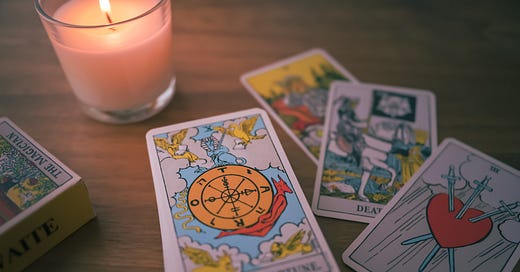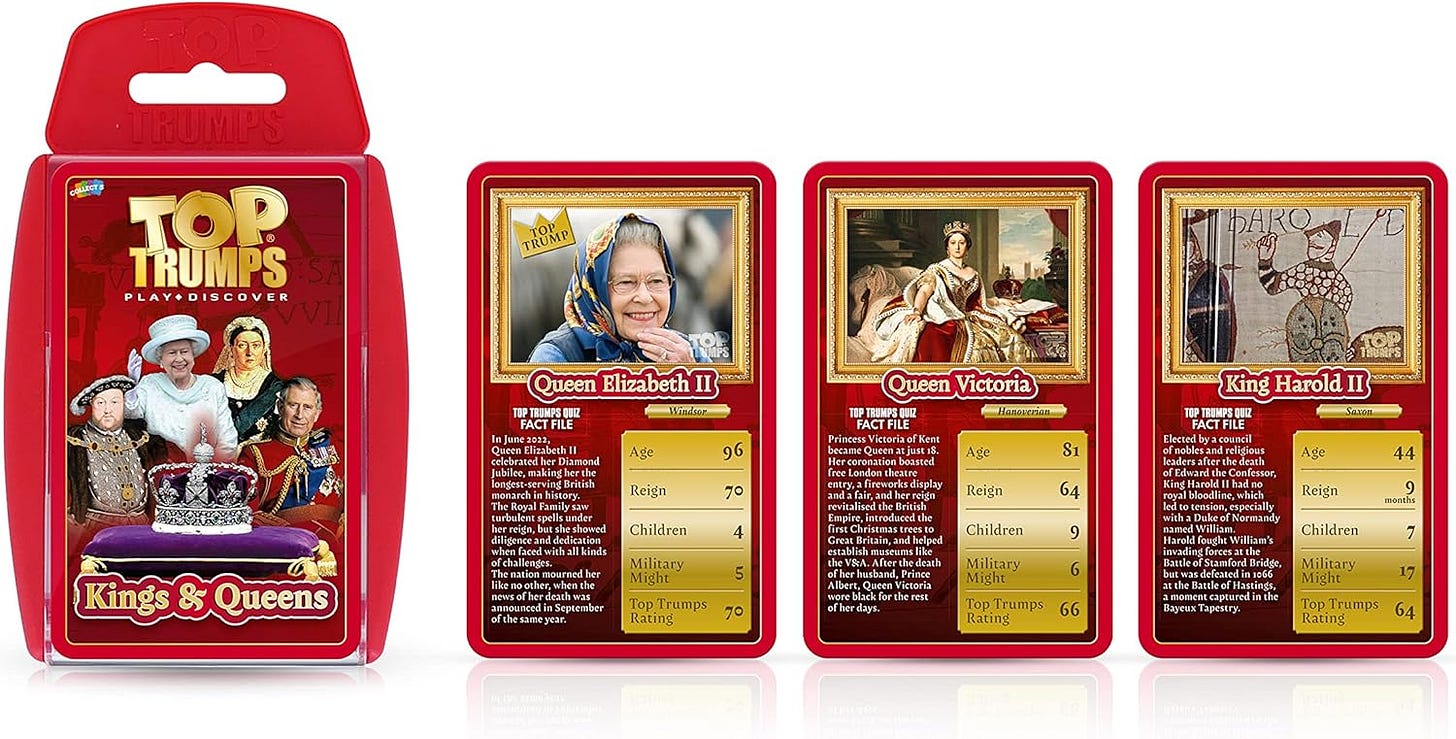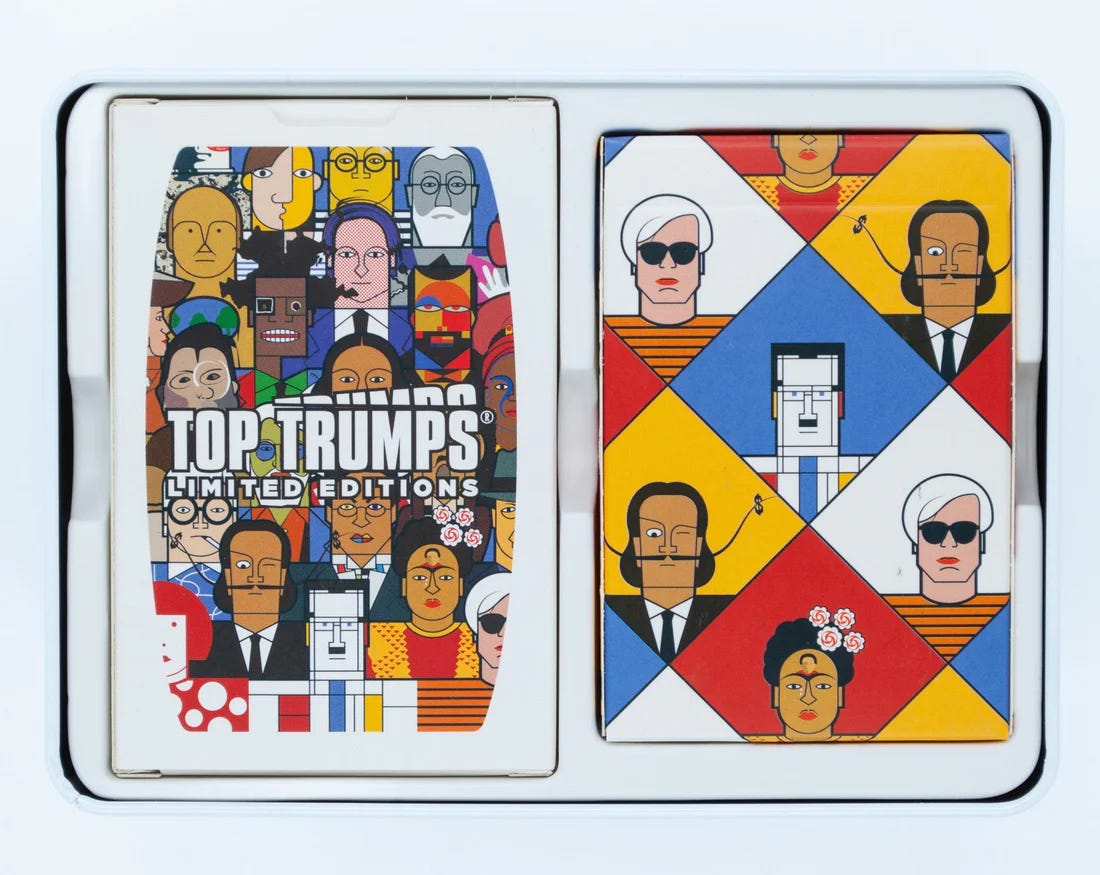I’m rubbish at card games. In part it’s because I can never follow the instructions - “pair means you have two cards of the same rank, plus three other unmatched cards. Got it?” - and there’s always the risk that there will be adding up involved. The rules of Shithead, a charmingly named game that I played a lot of during sixth form, must have been pretty simple because I managed them, but they are now lost to me. I get impatient when I don’t understand the rules, especially when we could be spending time talking about interesting things instead. Solitaire I can do, although no funny business with weird layouts are permitted on my watch. Really, only one card game has never caused me conniptions (other than the fact it has a Spiders edition) and that is Top Trumps.
For those sadly unacquainted with TT, it consists of a deck of cards on a particular theme. Each card has a list of numerical data, plus a photo or illustration. Equal numbers of cards are given to each player, then players compare these scores to try to trump and win an opponent's card. Cards that may score highly in one category can be absolutely hopeless on others - using the pack pictured below as an example, King Harold II absolutely trounces Queen Elizabeth II on military might, but she reigned for 70 years while he managed a scant nine months. So depending who has which card, and what they pick as the strongest attribute, the game proceeds until one player emerges triumphant. Unlikely to be poor old Harold.
The three versions I played as a kid were: Planets and Aliens, Fantasy (goblins and that sort of thing, nothing racy), and Cars (a roller-boot-shaped vehicle sticks in my mind as being a terrible scorer on all fronts). Now there are themes galore, from innumerable Harry Potter variants, Emojis, Apps, and Great British Bakes to Footballers, Film Directors, Deadliest Predators, Squishmallows and, god help us all, Elf on the Shelf. Using the format as a way to illustrate articles was such a regular suggestion in editorial meetings when I was a journalist that gusty sighs would be emitted whenever it was mentioned - especially from the designers who’d be tasked with making it look convincing.
But I won’t let that get in the way of the idea that’s been rattling around my brain. Because while great minds/marketing departments have already come up with Top Trumps for London Art Galleries, Great Modern Artists and Pots (Pot Trumps! I die!), I think that there could - should - be annual editions to mark the notable exhibitions that take place. They could be by calendar year, so January to December, or season, which, in the case of the London art scene, would be September to August. Not only would it be a fun game to play, comparing stats about how much square footage artists get, say, the most expensive collections, the best diversity and the number of stars awarded by critics, it would also be an aide-mémoire/cheatsheet of the biggest shows, plus some wildcards, that happen each year.
I missed this year’s Frieze exhibition in London - I was out of town, and apparently it can successfully go on without me - but if I had a Frieze Top Trumps I could catch up with who were the biggest beasts of the year. This year’s Turner Prize nominees’ show at Tate Britain (reviewed favourably in the Guardian here but rather more waspishly by its sister publication) would feature as one of the big shows in the 2024/2025 UK edition. Everyone in the art world would have a lovely time disagreeing about which shows were included and scoffing at the scores awarded and art students could crib useful facts about important retrospectives of years past. There could be international versions. I am far too lazy even to pretend that I am going to make this happen IRL, but it’s a neat thought, right?
I went away for a few days recently with a group of writers to give my inferiority complex something to really get its teeth into, and cards were a theme of our time together. There were no all-night poker sessions, praise be, but instead people shared the tarot and other decks that they used in their writing practices and their lives. I know that the mention of tarot can make people a bit eye-rolly, but it was the artwork that I first fell in love with as a teenager. The beauty and mystery of the illustrations on the classic Rider-Waite deck (not that you’d know they were the work of Pamela Colman Smith from the name) drew me in far more than the divination potential. (Even a bog-standard set of playing cards is an astonishing piece of design, isn’t it? Those crisp clubs and spades in business-like black, the drama of the scarlet hearts and diamonds and the extraordinary regal details of the court cards, the brocade robes, luxuriant mustachios, the sceptres and swords. That’s before we even get to the potential for the back of each card, a 2.5 in x 3.5 inch canvas.)
The romance of tarot’s imagery appealed to me, but I was horrified when I opened my first deck and realised that the familiar figures from the major arcana (familiar from the Bond film Live and Let Die, I’m afraid) were joined by zillions of other cards with numbers on them, in different suits, which all had different meanings. My brain went into “No thank you” mode realising how hard it would be to learn them all and I wrapped them in a silk scarf and shoved them in a box. I’ve dabbled since, and became quite obsessed with the Hermit card during a period of burnout, but always come up against a wall of my own ignorance.
So being away with people who knew about tarot and used it in fun, kind and creative ways was an absolute delight. I had my first reading with one of the writers, cross-legged on her bedroom floor, and was astonished at how many themes from the past six years of therapy came up. She shared her knowledge so gently and warmly that it was easy to talk about the Big Stuff. She also talked about particular tiny details on the cards that made me look at them in a new way. It was a visual way of interpreting meaning that was new and exciting.
Later in the week, another guest took us through an exercise using two different tarot decks. We pulled a card from each and went around the room deciphering what they might suggest to us. Again, the lore of the individual cards was explained, but we were also shown how to read our own meanings into what the artwork was communicating. In the past I’d got so caught up in not knowing how to use the cards “properly” I seldom went near them. Who knew I could enjoy them and use them before I had memorised the ins and outs of each one? Or that they could be read to suggest possible themes to write about, or solutions to creative problems? Also, what a shopping opportunity! I could get a set for every day of the week with vastly different art on each. (I’m mostly joking, although I know that a number of us ordered the Rainbow Tarot and the Oak, Ash & Thorn sets we were introduced to.) Personally, I’m keen to dig into Leonora Carrington’s set of Major Arcana cards next.
The final set of cards wasn’t quite as woo as the tarot. After breakfast one morning, a deck of Oblique Strategies was passed around the table. I’d heard of these cards, created by Brian Eno, but didn’t know anything about them. The official website describes them thus:
“In 1975, Peter Schmidt and Brian Eno created the original pack of Oblique Strategies cards, through thinking about approaches to their own work as artist and musician. The Oblique Strategies constitute a set of over 100 cards, each of which is a suggestion of a course of action or thinking to assist in creative situations. These famous cards have been used by many artists and creative people all over the world since their initial publication.” Elegant and sparsely designed, there was none of the baroque illustration of some of the tarot cards, but they were coolly beautiful in their minimalism.
Our creative circle pulled a card each, then we shared with everyone. Cards that might have been baffling or depressing on first reading were interpreted differently when analysed by the group. As a dreadful chatterbox, I smiled wryly when I read the card I’d chosen. “Listen to the quiet voice”, it instructed. The quiet voice of the card, I think, was one I’ve been ignoring for a long time. It was getting louder last week, in that group of brilliant, published authors. It said that I should write more, that I needed to spend time getting better, that no-one is born knowing how to write a book and that trying and failing is better than never giving it a go.
It was scary, this card, more so than the misplaced alarm one might feel upon drawing the Death card in tarot (not usually actual death - just the end of something, which means the start of something else) or the Hanged Man (again, you’re not headed for the scaffold, it means sacrifice, new perspectives and waiting for the right time).
Although now I come to think of it, both of those would be apt, too. So it looks like it’s time to play my cards right and try and make a good hand of it.












Love all of this so much! I think next time we’re together we should create our own must be nice deck! 😉
Love this! Yes to feeling brave enough to use the cards even if we do not fully understand them yet, and yes, always, to the quiet voice. 💫🔮